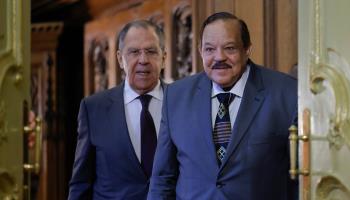Russia is reinforcing its presence in Sudan and Libya amid uncertainty over its bases in Syria
Russia has resurrected an agreement with Sudan over the development of a Russian naval base, while simultaneously bolstering its military infrastructure in Libya. These moves occurred alongside ongoing uncertainty over the future of Russia’s bases in Syria. Rather than seeking to replace its Syria facilities, Moscow appears to be developing a diversified network of military infrastructure that reduces its vulnerabilities.
What next
Subsidiary Impacts
- Moscow will continue to seek an agreement with the new leadership in Syria to maintain its naval and air bases.
- The base in Libya will facilitate logistical support to other operations in Africa.
- Russia will likely seek to continue transferring equipment to Mali as part of any Syria drawdown.
Analysis
On February 12, Sudanese Foreign Minister Ali al-Sharif reported that he had reached an agreement with his Russian counterpart, Sergei Lavrov, to host a Russian naval base at Port Sudan. His comments followed a working visit to Moscow, which Russia characterised as “focused on the developments in Sudan with an emphasis on the prospects for resolving the ongoing military and political crisis in that country.”
Port Sudan long coveted by Moscow
The talks over the naval base resurrected an agreement first discussed with the Omar al-Bashir government in 2019. Following Al-Bashir’s ousting in a military coup, the new Sudanese authorities initially signed an agreement with Russia in November 2020 but placed it under review in mid-2021. Al-Sharif now says there are “no obstacles” to implementing the deal. Port Sudan is the current headquarters of the Sudanese Armed Forces (SAF) and the country’s de facto president, General Abdul Fattah al-Burhan.
Establishing a permanent military presence in Sudan is a long-term strategic goal for Russia, and Russian foreign and defence officials have repeatedly visited the country.
Commenting in mid-2021, Rear Admiral Arkady Syroyezhko, a former senior military official, argued that a base “could guarantee the security of strategic sea transport routes” and facilitate the “expansion of military-political and military-technical cooperation with countries in the region.”
Russia’s 2022 Maritime Doctrine did not directly refer to Sudan but did call for the development of relations with states that can provide access to the Mediterranean and Red Seas.
According to the original agreement, Russia would have gained 25-year leasing rights to develop a naval logistics hub at Port Sudan capable of hosting warships, including nuclear-powered vessels, and up to 300 personnel. It is unclear whether the terms of the current agreement are identical.
Russia reinforces Libyan military operations
Sudan is not the only African country where Russia is seeking to strengthen its position amid uncertainty over its military presence in Syria following the downfall of President Bashar al-Assad (see RUSSIA: Syrian military bases may not be lost – February 17, 2025).
Russia has also been modernising the Maaten al-Sarra air base, located in south-eastern Libya near the borders with Chad (100 kilometres) and Sudan (300 kilometres). The base is situated in an area under the control of long-time Russian ally, Libyan National Army (LNA) leader Khalifa Haftar.
Russia has reinforced its Libyan air bases
The Maaten al-Sarra base would provide a logistics platform for supporting the operations of the Wagner Group and African Corps in other African countries, including the Central African Republic, Mali, Niger and Burkina Faso (see RUSSIA: African Corps will remain engaged in Mali – August 19, 2024).
Satellite images show that barracks and vehicles first appeared on the old air base in July 2024. Shortly afterwards, work began on restoring the runway, which was completed in February 2025 and is now capable of accommodating Ilyushin-76 cargo planes. Aircraft tracking data show cargo planes now bring equipment and personnel to the site daily. Russia also operates airbases at Al-Khadim (Al-Kharouba), Al-Jufram, Brak al-Shati and Al-Qardabiya.
Uncertainty hampers long-term planning
The Russian authorities have been notably cautious about the latest agreement with Sudan. Lavrov did not comment on the agreement during the press briefing with Al-Sharif and the Russian Foreign Ministry’s official readout of the talks similarly neglected to mention it. The issue did not attract significant coverage in the mainstream Russian press.
This suggests a lack of Russian confidence in the deal, which still needs to be ratified. The SAF is embroiled in a civil war with the Rapid Support Forces (RSF), and Russia has long supported both parties to the conflict.
Moscow is concerned about the reliability of the Sudanese government
Russia now appears to favour the SAF, with Deputy Foreign Minister Mikhail Bogdanov reportedly offering “uncapped” military assistance following talks in April 2024. Nevertheless, the long-term security of the Sudanese regime is far from certain, and Russia may be hedging its bets by maintaining ties to both sides.
Moscow’s apparent hedging strategy could be a response to the RSF’s ascendancy over government forces on the battlefield, or a move designed to increase pressure on the SAF to ensure it respects its agreements with Moscow (see SUDAN: RSF government increases partition risk – February 27, 2025).
Similar uncertainty hampers long-term planning in Libya, where the LNA competes with the Government of National Unity. Russia has long been rumoured to be seeking to develop a naval base in the country, with Tobruk, Susah or Sirte discussed as viable options. However, these would be long-term projects and could provoke nationalist sentiment within Libya and resistance from the United States.
Russia seeks diversified options rather than Syria substitute
From Moscow’s perspective, each of the alternatives to Syria has limitations. Libya lacks deep-water port facilities and Maaten al-Sarra obviously cannot support naval operations. Port Sudan, by contrast, lacks access to the Mediterranean Sea. Building or modernising facilities will also take time.
Nor has Russia abandoned its efforts to maintain its presence in Syria, where negotiations with the new authorities over the future of the Tartous naval base and Hmeimem air base are ongoing. Syrian Defence Minister Murhad Abu Qasra has signalled that the authorities are willing to allow Russia to keep both bases if it serves Syria’s interests. He has explicitly embraced the idea that, in politics, there are no permanent enemies, only interests. Both sides, therefore, appear to be adopting a highly pragmatic approach to negotiations.
As such, developments in Sudan and Libya can be considered part of a broader strategic effort to mitigate contingencies. Other developments — the transfer of military equipment from Syria to Mali, efforts to strengthen military cooperation with Algeria and a small military deployment of a few hundred troops to Equatorial Guinea — fit the same pattern.
Rather than seeking a single option that can meet all of its needs, Russia appears to be developing multiple options simultaneously, which will reduce its vulnerability to deteriorating political circumstances in, and relations with, any one country. This is important due to the constant risk that local dynamics — over which Russian forces have little control — could result in changes of government.



